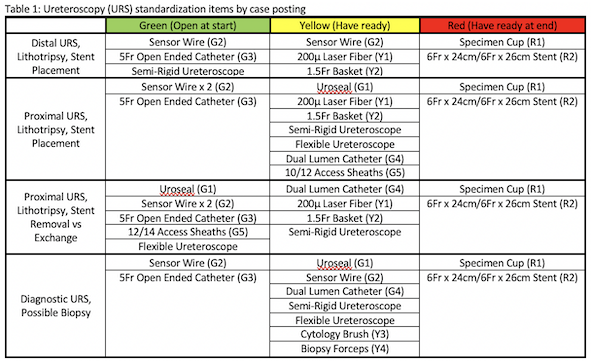Back
Poster, Podium & Video Sessions
Moderated Poster
MP10: Education Research I
MP10-18: Ureteroscopy Standardization and its Impact on Efficiency in the Operating Room
Friday, May 13, 2022
1:00 PM – 2:15 PM
Location: Room 228
Jordan Goldwag*, Laila Bangash, Andrew Harris, Lexington, KY
- JG
Jordan Goldwag, MD
University of Kentucky
Poster Presenter(s)
Introduction: Ureteroscopy is a common urologic procedure with significant variability from one case to the next. The operating surgeon often does not know the exact products that will be needed for a case until the procedure is under way. With sometimes hourly changes to ancillary operating room (OR) staff throughout the day, the assistants in the OR for a particular case can be less familiar with the subtleties of ureteroscopic instrumentation. This can lead to wasted, unnecessary OR time waiting for items to be located, accessed and opened. By implementing this ureteroscopy standardization, we sought to decrease time spent on locating and opening products.
Methods: We implemented a system at our local Veterans Affairs Medical Center (VAMC), where cases were posted to indicate the common instruments and products predicted to be used during that procedure. Instead of posting a case as ureteroscopy, table 1 details four separate postings that were used to relay to the OR staff which items would likely be needed during a specific case. There was a color-coded system where “Green”, “Yellow” and “Red” products indicated that the OR staff should have these items opened at the start, ready to open during the case and ready to open at the end of the case, respectively. There was also a coding system implemented to easily locate items in the cystoscopy suite, for example “G2” instead of “Sensor Wire”. We recorded various outcomes in ureteroscopy cases prior to and after implementation of our standardized processes.
Results: 55 cases were examined prior to intervention and 13 cases following intervention. When comparing before and after intervention, there were statistically significant differences in mean time to locate requested product (125.2 vs 42 seconds, p = 0.005), mean time staff was out of the room locating products (84.4 vs 14.7 seconds, p = 0.005) and mean time operating surgeon’s attention was diverted (65.5 vs 6.2 seconds, p = 0.007). There was also a significant decrease in the percentage of OR time spent locating and opening products (3.26% vs 1.39%, 0.005)
Conclusions: Standardizing the methods by which products are located and used during ureteroscopy can decrease unnecessary time spent in the operating room.
Source of Funding: None

Methods: We implemented a system at our local Veterans Affairs Medical Center (VAMC), where cases were posted to indicate the common instruments and products predicted to be used during that procedure. Instead of posting a case as ureteroscopy, table 1 details four separate postings that were used to relay to the OR staff which items would likely be needed during a specific case. There was a color-coded system where “Green”, “Yellow” and “Red” products indicated that the OR staff should have these items opened at the start, ready to open during the case and ready to open at the end of the case, respectively. There was also a coding system implemented to easily locate items in the cystoscopy suite, for example “G2” instead of “Sensor Wire”. We recorded various outcomes in ureteroscopy cases prior to and after implementation of our standardized processes.
Results: 55 cases were examined prior to intervention and 13 cases following intervention. When comparing before and after intervention, there were statistically significant differences in mean time to locate requested product (125.2 vs 42 seconds, p = 0.005), mean time staff was out of the room locating products (84.4 vs 14.7 seconds, p = 0.005) and mean time operating surgeon’s attention was diverted (65.5 vs 6.2 seconds, p = 0.007). There was also a significant decrease in the percentage of OR time spent locating and opening products (3.26% vs 1.39%, 0.005)
Conclusions: Standardizing the methods by which products are located and used during ureteroscopy can decrease unnecessary time spent in the operating room.
Source of Funding: None


.jpg)
.jpg)